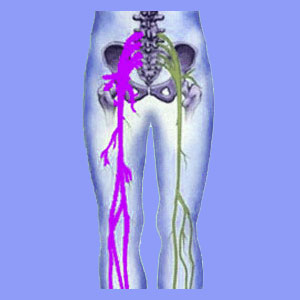
What is sciatica? This is a question asked very frequently by patients who are diagnosed with this epidemic lower body neuralgia condition. Sciatica is the most common lower back and leg pain complaint reported by patients around the world. However, it is a greatly misunderstood symptom syndrome by both doctors and patients alike.
This resource section will examine sciatica objectively and completely. We will detail many facts and misconceptions about sciatic nerve pain. We will also take an in-depth look at some of the most important related topics which can help patients to fully understand exactly what sciatica really is and what it is not.
What is Sciatica? / Definitions
Sciatica is defined as spinally-induced nerve pain which radiates into the buttocks, legs, ankles or feet. It is most commonly experienced in conjunction with lower back pain, but is sometimes present in the lower extremities alone.
Every patient will demonstrate a unique symptomology and rarely are 2 cases exactly alike. It is quite impossible to describe an average case of sciatica due the wide range of possible pain patterns and locations.
It should be noted that there are many causes for sciatica-type symptoms, although if the source does not reside in the spine, then the expression can not be qualified as true sciatica. In cases such as piriformis syndrome, muscular concerns or localized nerve dysfunction, the more accurate description of the symptoms is pseudo-sciatica.
Sciatica Explanations
These essays help to define sciatica and explain the fundamental points of the condition:
Genetic sciatica describes back and leg pain syndromes that are influenced by hereditary factors.
Chronic sciatica denotes symptoms that exist every day for an extended timeframe.
Acute sciatica is a torture, since symptoms can flare-up quickly and completely debilitate any patient.
Morning sciatica is a horrible feeling to have early in the day.
Learning all about sciatica is the first step in beating the condition.
Peripheral neuropathy sciatica can affect the smaller nerve tissues in a regional area.
Sciatica in the back of the legs is one of the most common locations for symptoms to occur.
Sciatica in the ankles is typically found right at the juncture of the foot or in the lower rear calf muscle.
Sciatica neuralgia describes general nerve pain expressions that are an inherent part of most symptomatic complaints.
Our sciatica relief program can prevent, manage and cure pain caused by a wide range of diagnosed conditions. Best of all, it is 100% safe and endorsed by many doctors and international healthcare organizations.
What is Sciatica? / Symptoms
Sciatica symptoms vary from one individual to the next. There might be lower back and buttocks pain and this discomfort might be severe. Muscular spasms sometimes accompany the pain and are surely one of the most agonizing conditions a person could ever be forced to endure. The patient might also experience tingling, numbness and/or weakness in the lower limbs. Theses symptoms might follow a distinct and predictable pattern or might move around often.
Patients might experience these symptoms in the groin, thighs, knees, backs of the legs, calves, ankles or feet. The pain might be acute and debilitating or dull and achy. Pain may be linked to a particular position or activity or might come and go seemingly without cause.
The most common sciatica condition is described as chronic dull pain which rarely goes away. This pain is often worsened by some positions or activities. Most patients also suffer recurrent bouts of acute pain and often endure muscular spasms which cripple the poor soul for days at a time. Once the acute attack is over, the chronic pain and fear return to haunt the patient until the next agonizing episode.
Sudden sciatica can be very frightening. Learn why the attack can begin so quickly and escalate to debilitating degrees.
Do I have sciatica? If you are not sure, we can help you to understand all the possible explanations for your pain.
What is Sciatica? / Causes
There is a wide range of sciatica causes spanning the full gamut of the human experience. Physical injury, such as a herniated disc, is the most common diagnosis; but these types of injuries usually heal well on their own or with appropriate medical interventions.
Normal spinal degeneration is also blamed for creating many cases of sciatic nerve pain, although these diagnoses are often incorrect. Degenerative disc disease, facet joint syndrome and osteoarthritis are completely expected parts of the aging process and are not normally to blame for any serious or ongoing symptoms.
One of the more common actual causes of ongoing chronic or recurrent acute sciatica is simple cellular ischemia. This condition affects millions of people, but is rarely correctly identified as the actual source of pain.
As you learn more about sciatica on this site, you will discover the huge incidence of misdiagnosis which occurs daily in the back pain industry and why sciatica has such a bad reputation as a chronic and disabling condition.
Sciatica is…
The answer to the question “What is Sciatica?” is a simple statement which I can pronounce with absolute certainty, having suffered with sciatica pain for the vast majority of my life: Sciatica is a nightmare. Does this answer your question? It is my goal on this site to teach you all about sciatica and why it has become such a burden on patients and our healthcare system, in general.
To defeat your enemy, you must understand your enemy. Remember that the prognosis for sciatica is not good. You must do everything to stack the odds for successful treatment in your favor.
Once you comprehend what makes sciatica so difficult to accurately diagnose, you will also clearly see why most medical, complementary and alternative treatment approaches show such poor results for resolving the pain. This is the first step in finding an effective cure.
If you have a specific question about sciatica, please read our FAQ page to get your answer immediately.






